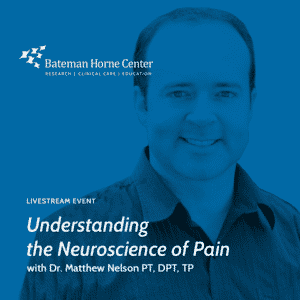
What is Pain?
When the body is injured, neurons signal the brain that something is wrong. The brain responds with pain. This clarifies the common misconception that pain is an input to our brains. In reality pain is the brain’s output, or response to an injury. The pain alerts us that we need to address the source of pain.
Since pain is an output, not an input, it can be adjusted by different factors. For instance, stepping on a Lego usually hurts—a lot. However, if we are trying to escape a room on fire, we would experience much less pain stepping on a Lego because our brain has decided that there are bigger issues at hand.
The body is often good at handling issues without experiencing pain. Body scans show many times when an issue we typically associate with pain—such as a bulging disc—both appears and heals without triggering any pain in the process.
This is all well and good for short and simple pain, but pain becomes harder to manage when it’s chronic and complex. Brain scans show that pain tends to be processed in areas of the brain that deal with emotions, movement, concentration, problem solving, memory, fear, stress responses, balance, cognition, and special recognition. Therefore, chronic or complex pain can negatively affect any or all of these areas by taking up space that would otherwise be devoted to these important life enriching areas.
Chronic pain also has implications for the way our brain processes pain. For instance, increasing pain is usually not a sign of degrading tissues; instead, this is a product of the brain becoming so efficient in dealing with pain, that we experience pain more rapidly than before.
Furthermore, one in four people’s brains do not calm down after a pain experience. When this happens, it only takes a small injury to trigger a significant pain response, since the brain remained very close to the pain threshold after the last experience. This is a condition known as sensitive nerves.
Addressing Pain through Physical Therapy
Physical therapists are trained to help people better manage their pain. For instance, a physical therapist might help a patient with sensitive nerves learn to bring down their pain sensitivity. Physical therapists accomplish their treatments through a careful mix of education, exercises, and homework.
Physical therapy is best done in one-on-one sessions, although it can be done in small groups, and is covered by most insurances. Typical physical therapy can last 6-10 sessions with 15-30 minutes per session.
When entering physical therapy, you can expect to give a history of the pain, use outcome measures to track your progress, screenings and tests to check how much you can move, and be educated on what your medical provider learned. From there, you and your medical provider will discuss and implement goals and interventions tailored to your situation.
Pillars of Pain Management
There are many treatment approaches to pain, but the most important pillars of pain management are sleep hygiene and goal setting, as well as exercise if appropriate and manageable.
First, sleep hygiene does not necessarily mean that you sleep well. Sleep hygiene means that you do everything in your power to rest as well as possible. This includes advice such as maintaining a consistent sleep schedule and turning off all technology at least an hour before bed.
Second, goal setting is a powerful way to move forward. You should create both short-term and long-term goals making sure to write them down. A Harvard study found when people did not write down their exercise goal only a third of participants reached their goal, while 91% of participants who wrote down their goal achieved it. Above all, create goals that are SMART: specific, measurable, attainable, realistic, and timely.
Third, and only as able, do aerobic and strengthening exercises five days a week. This advice is not applicable to patients who cannot maintain such activity levels without relapsing. However, for people who are able to perform such exercise, it is key to set a consistent exercise schedule. This exercise is important because nerves thrive on space, movement and blood. When exercising, nerves abundantly receive all three. Many people with chronic pain find it easier to exercise earlier in the day when they are not as fatigued. No matter your activity level, prioritize avoiding a crash-relapse cycle.
We gratefully thank Doctor Nelson for his time and talent in discussing pain and pain management. The Bateman Horne Center is dedicated to providing quality resources to people everywhere, and deeply appreciates Doctor Nelson’s contribution to this mission. If you would like to contribute to the Bateman Horne Center’s mission, you can become a healthy volunteer in our latest study or donate to the Bateman Horne Center today.


 Lucinda Bateman, MD, is a renowned clinician, researcher, and educator. Her Johns Hopkins University Medical School training instilled an approach to care that she has employed throughout her career - the patient comes first and the unknown or unexplained does not equate to a lack of proper and compassionate care. Since starting her own practice in 2000, she has served on six boards or committees, been the principal investigator for 45 studies, authored/coauthored 40 journal articles, served as adjunct instructor and adjunct assistant professor in the University of Utah Departments of Preventative Medicine, Internal Medicine, and Anesthesiology, and lectured around the world.
Lucinda Bateman, MD, is a renowned clinician, researcher, and educator. Her Johns Hopkins University Medical School training instilled an approach to care that she has employed throughout her career - the patient comes first and the unknown or unexplained does not equate to a lack of proper and compassionate care. Since starting her own practice in 2000, she has served on six boards or committees, been the principal investigator for 45 studies, authored/coauthored 40 journal articles, served as adjunct instructor and adjunct assistant professor in the University of Utah Departments of Preventative Medicine, Internal Medicine, and Anesthesiology, and lectured around the world.